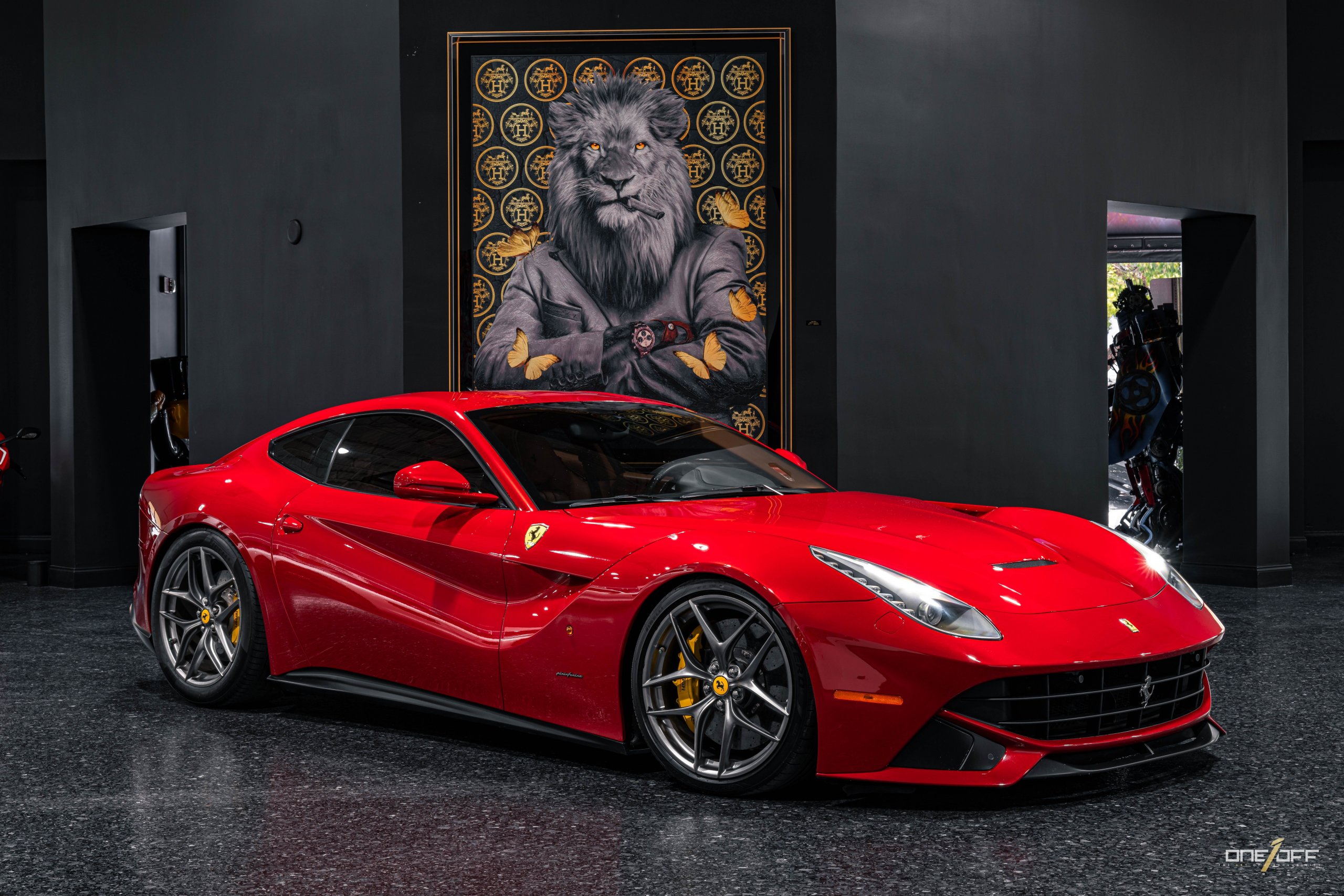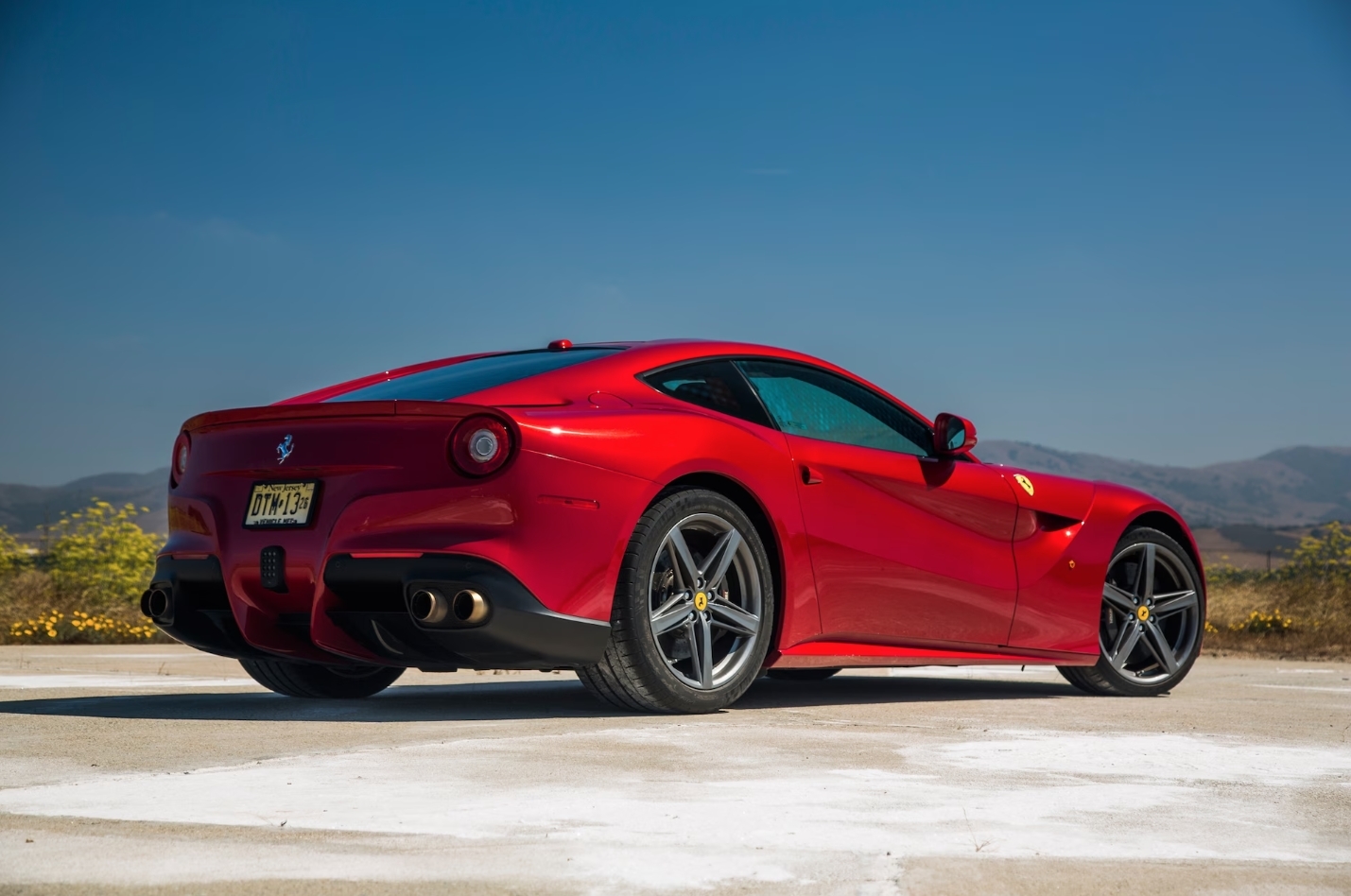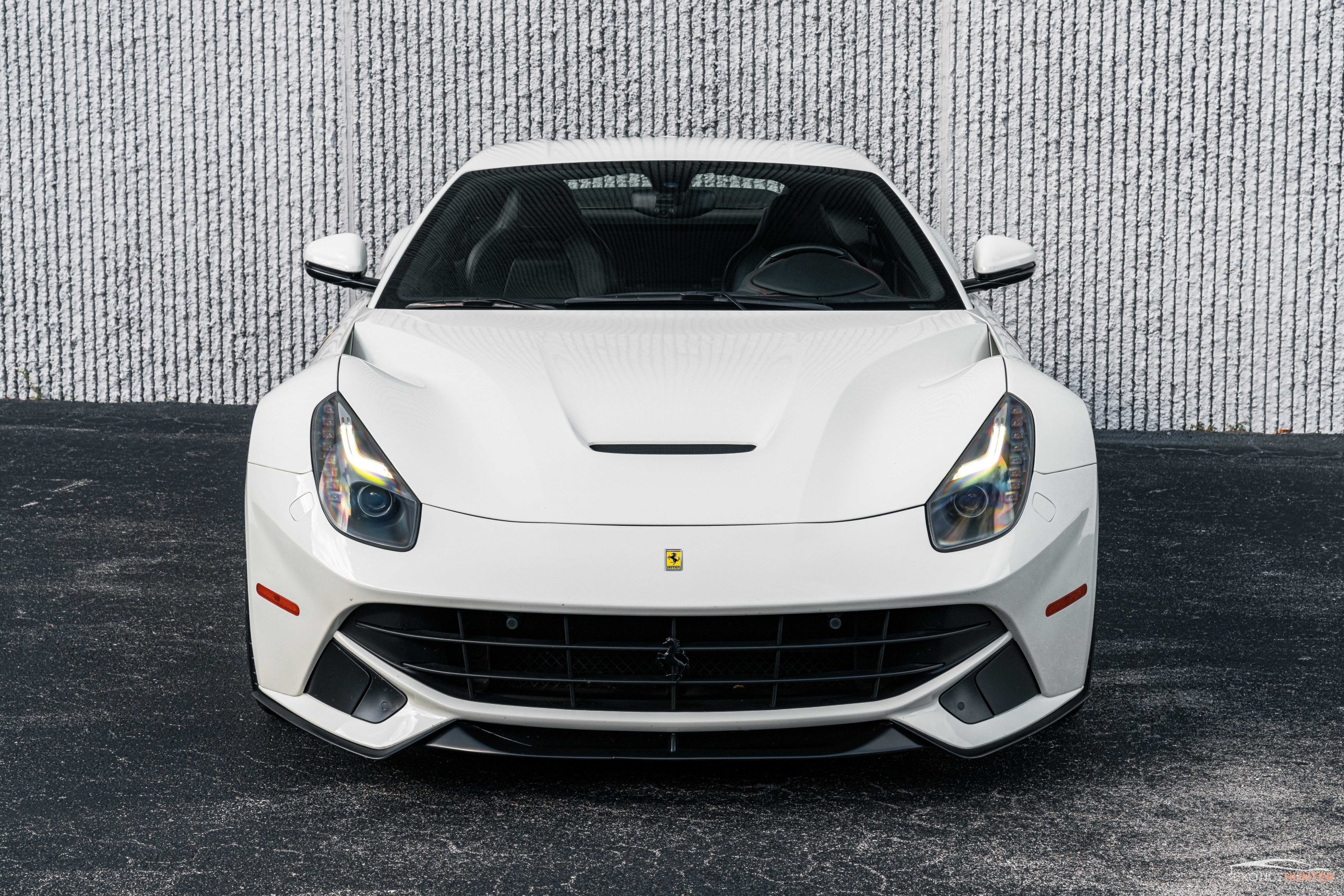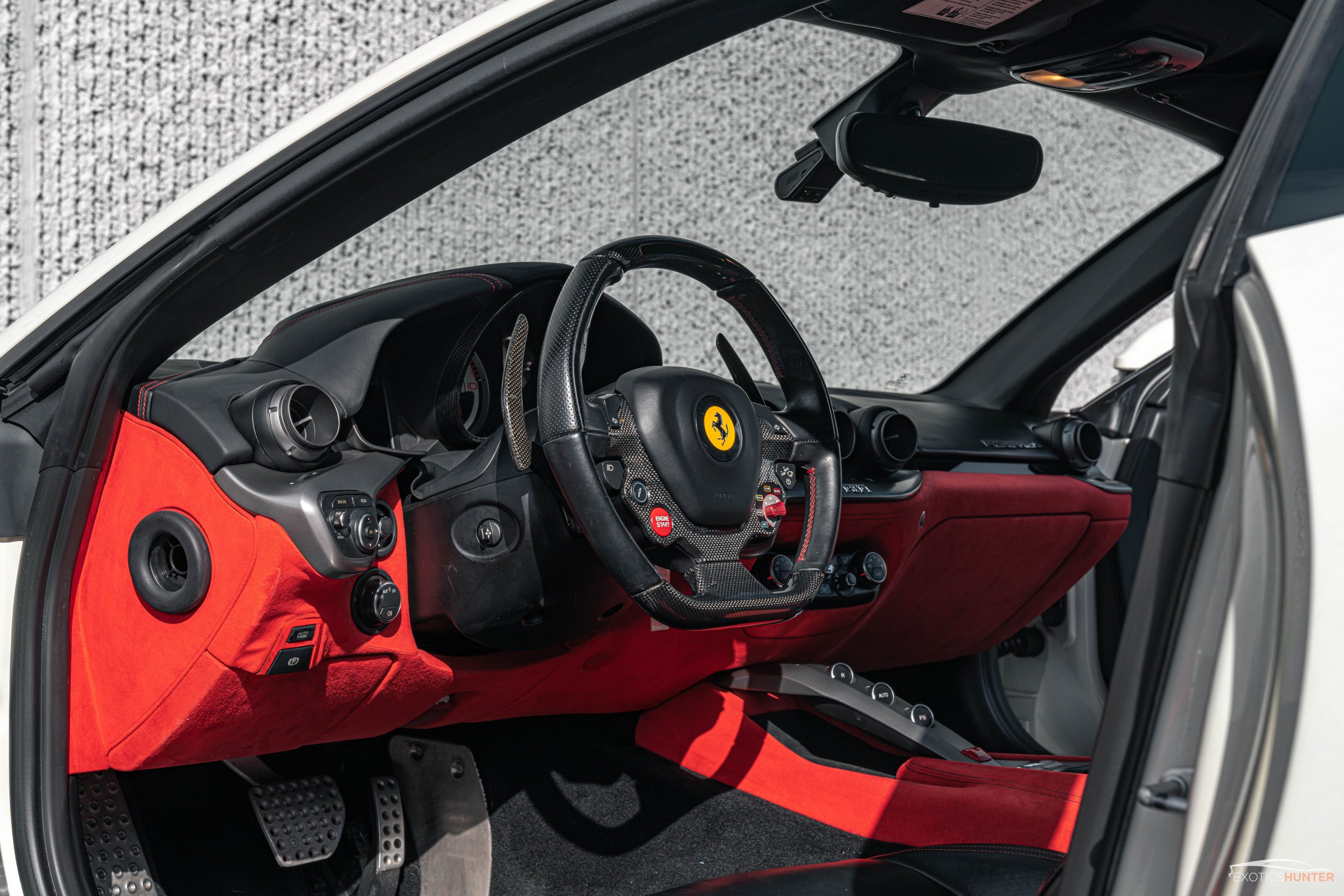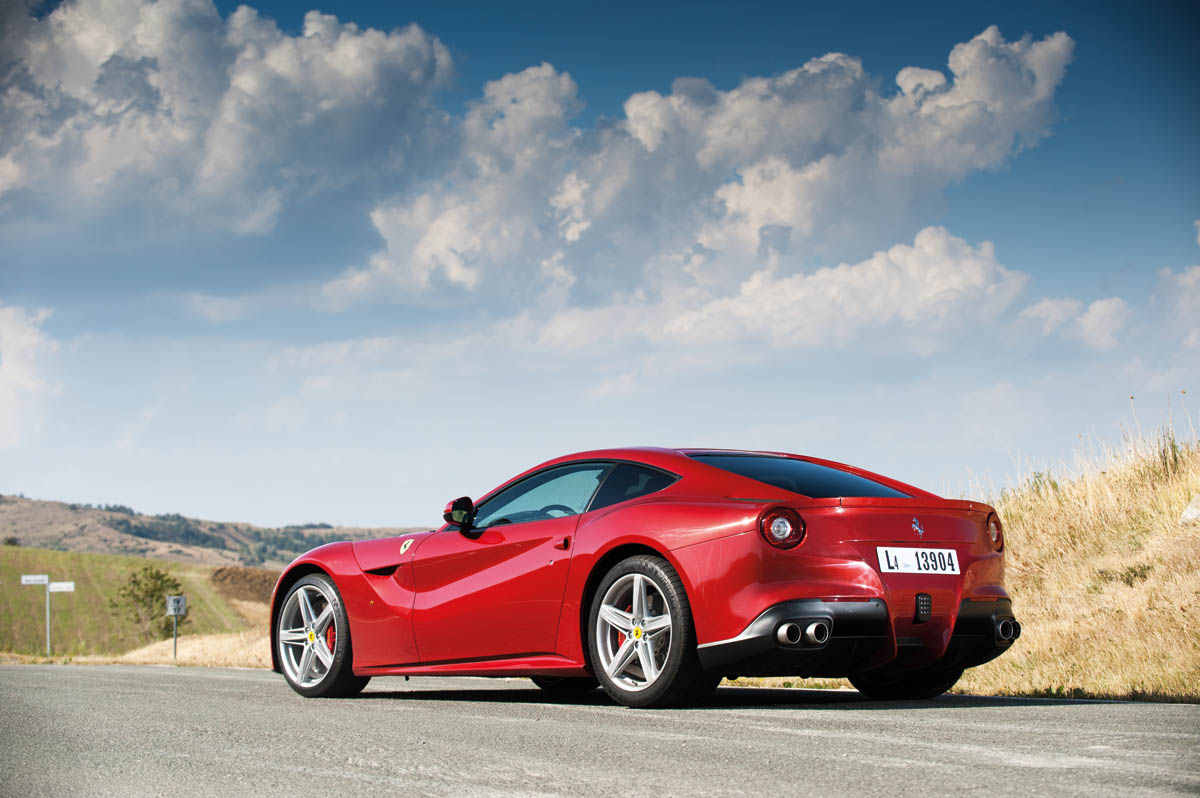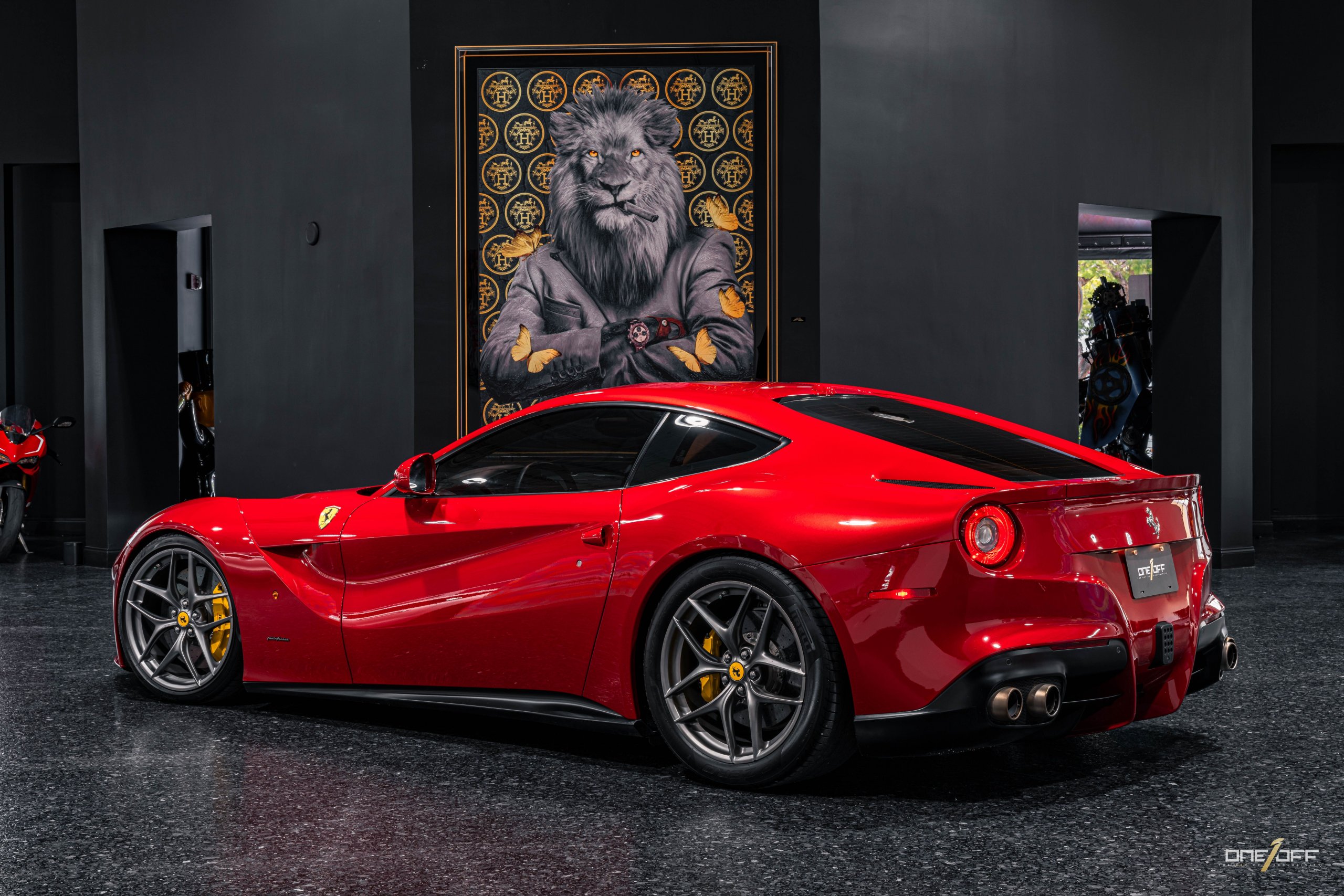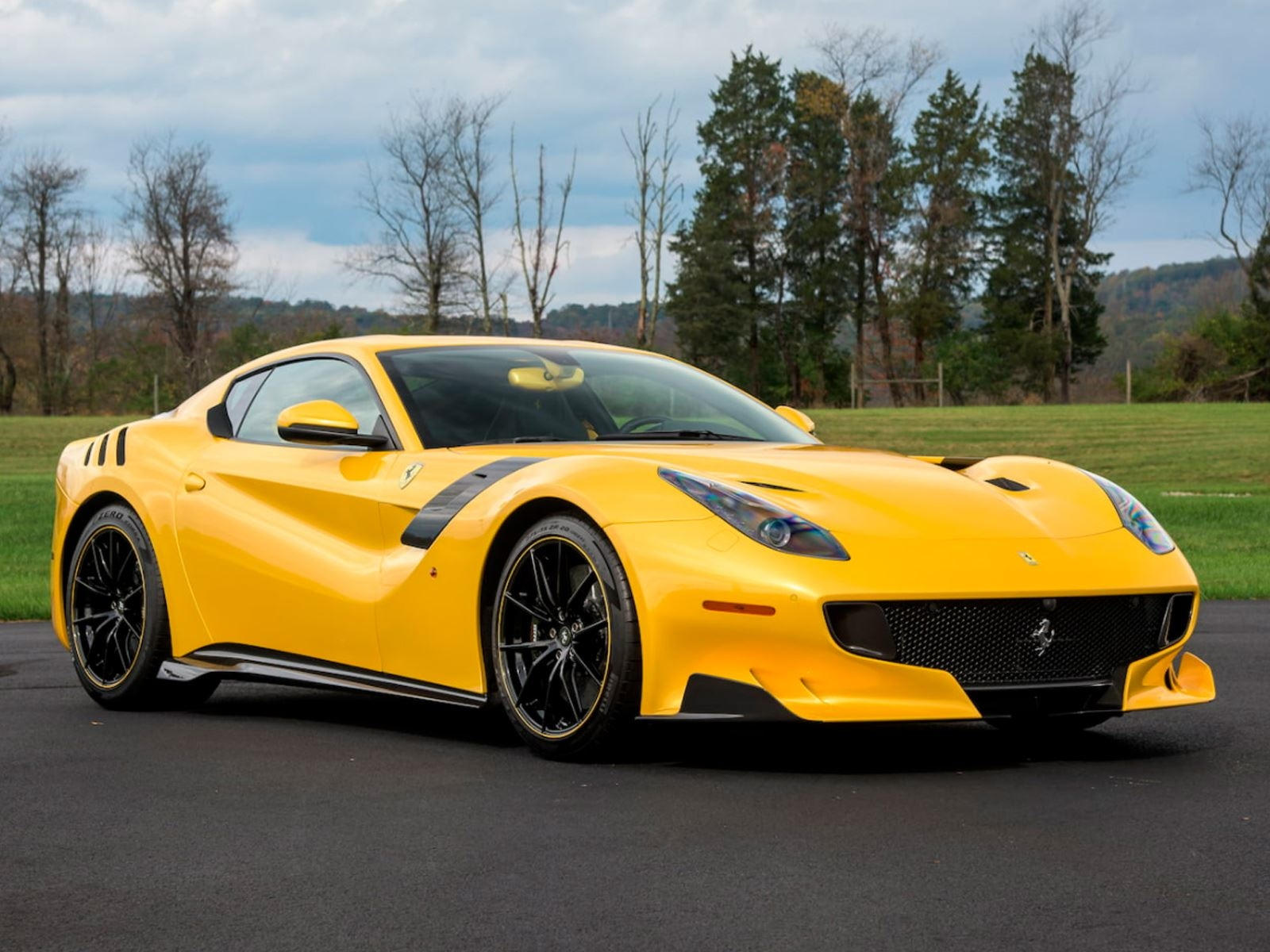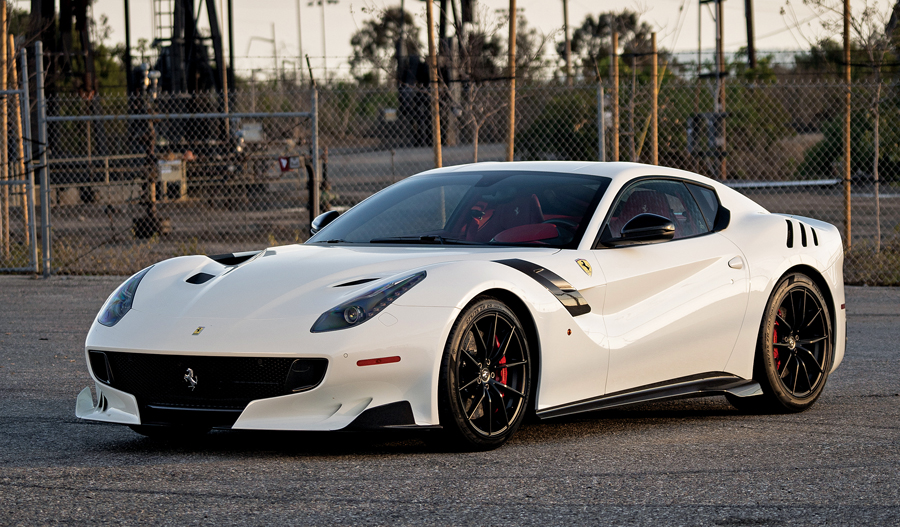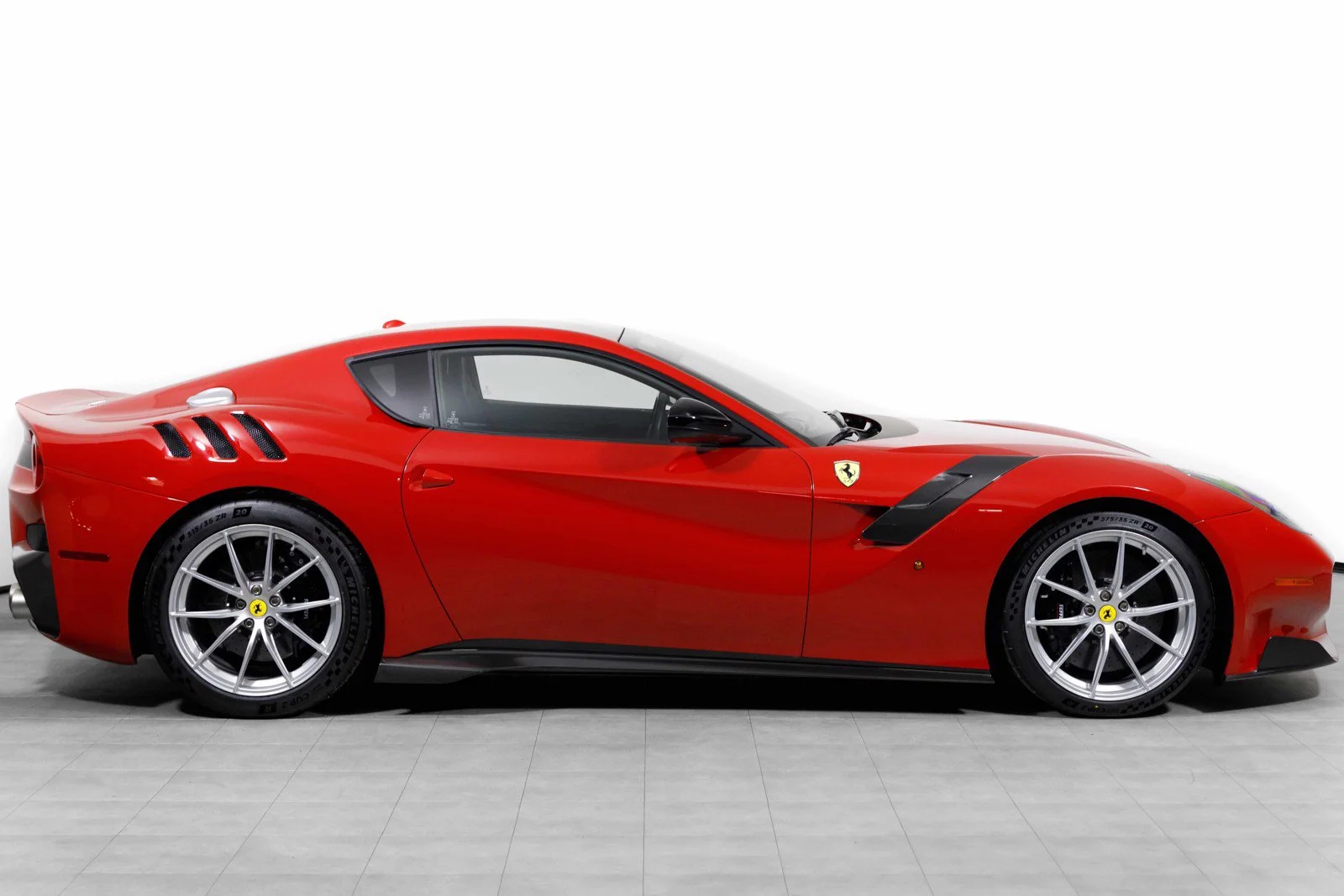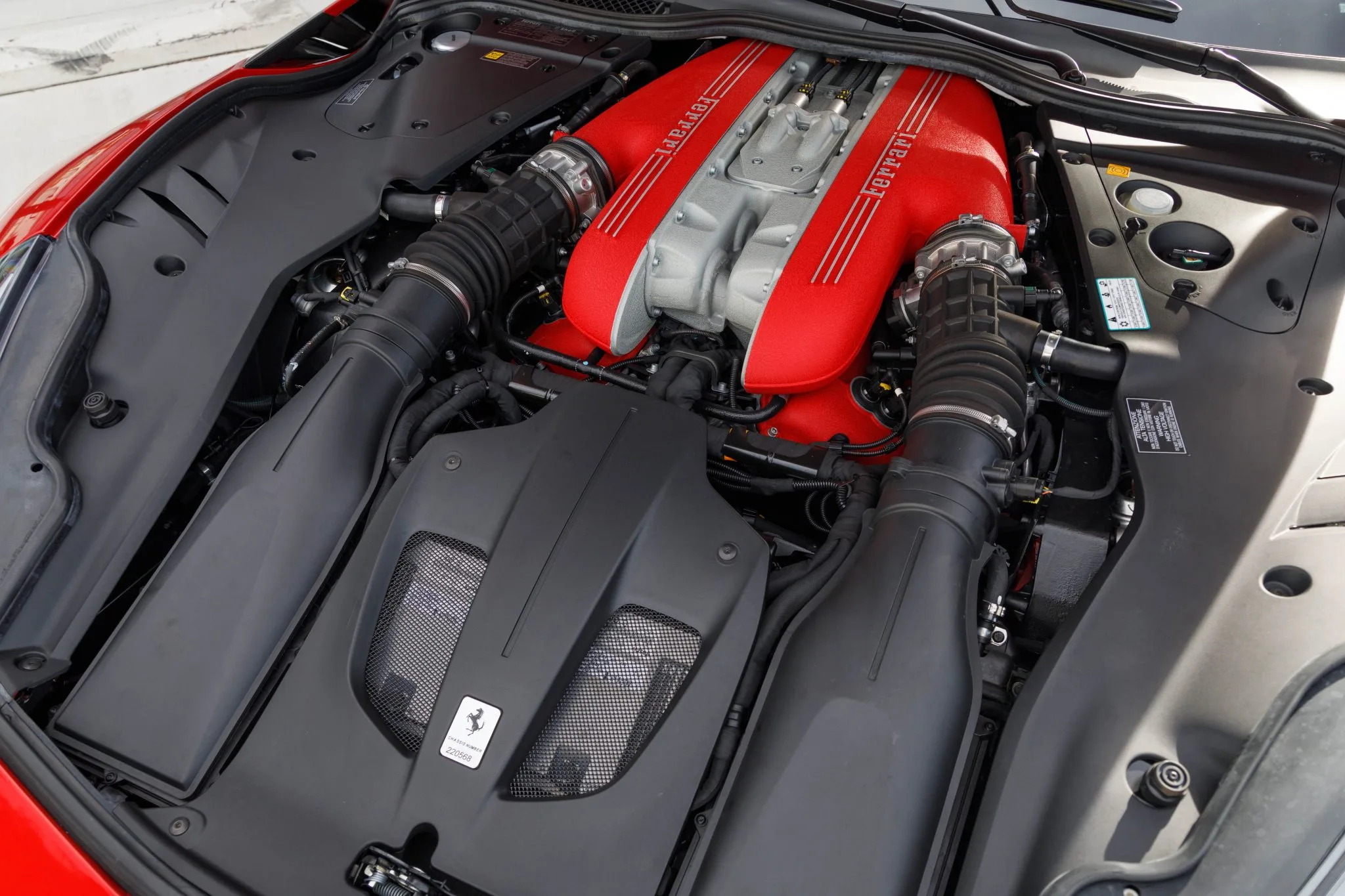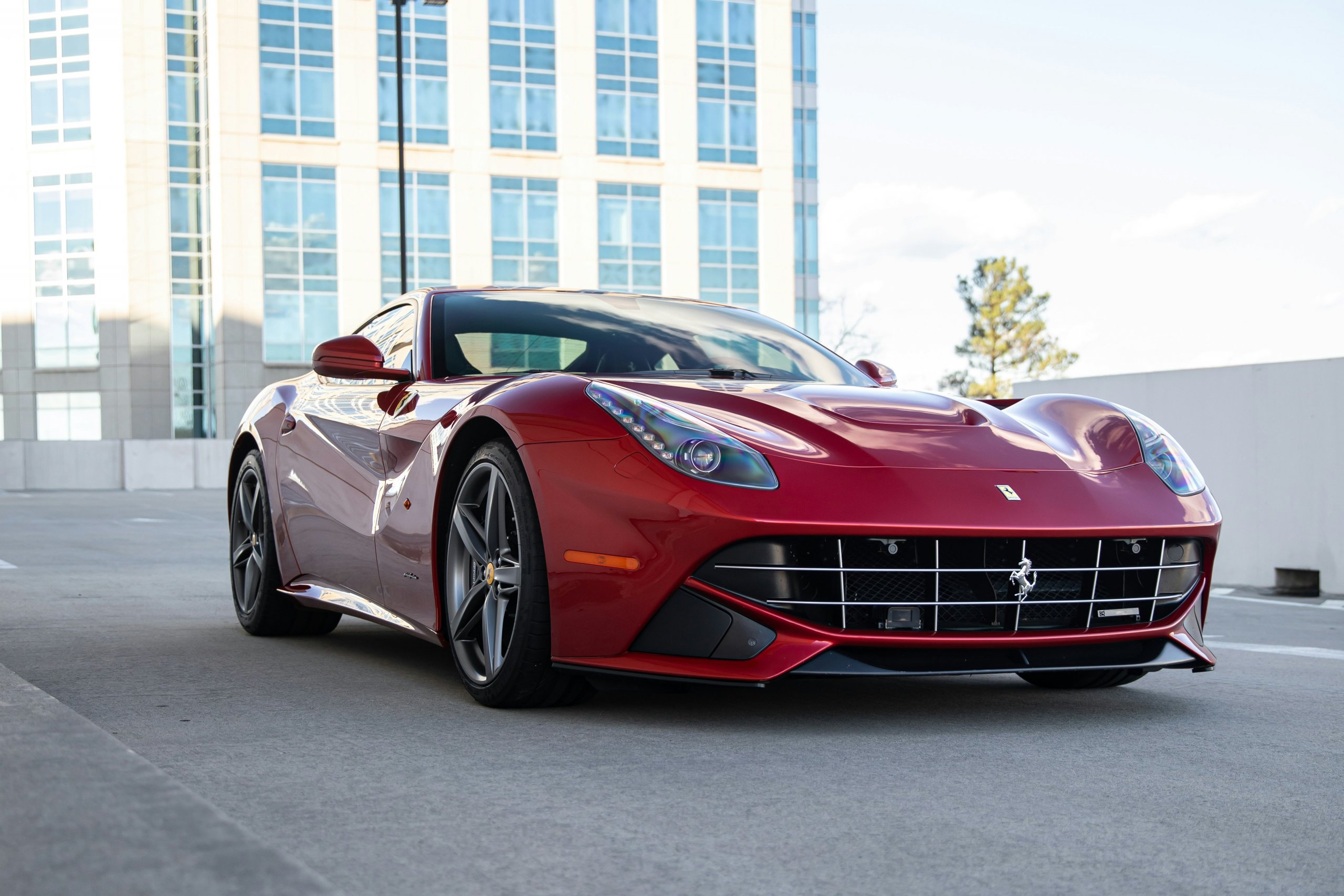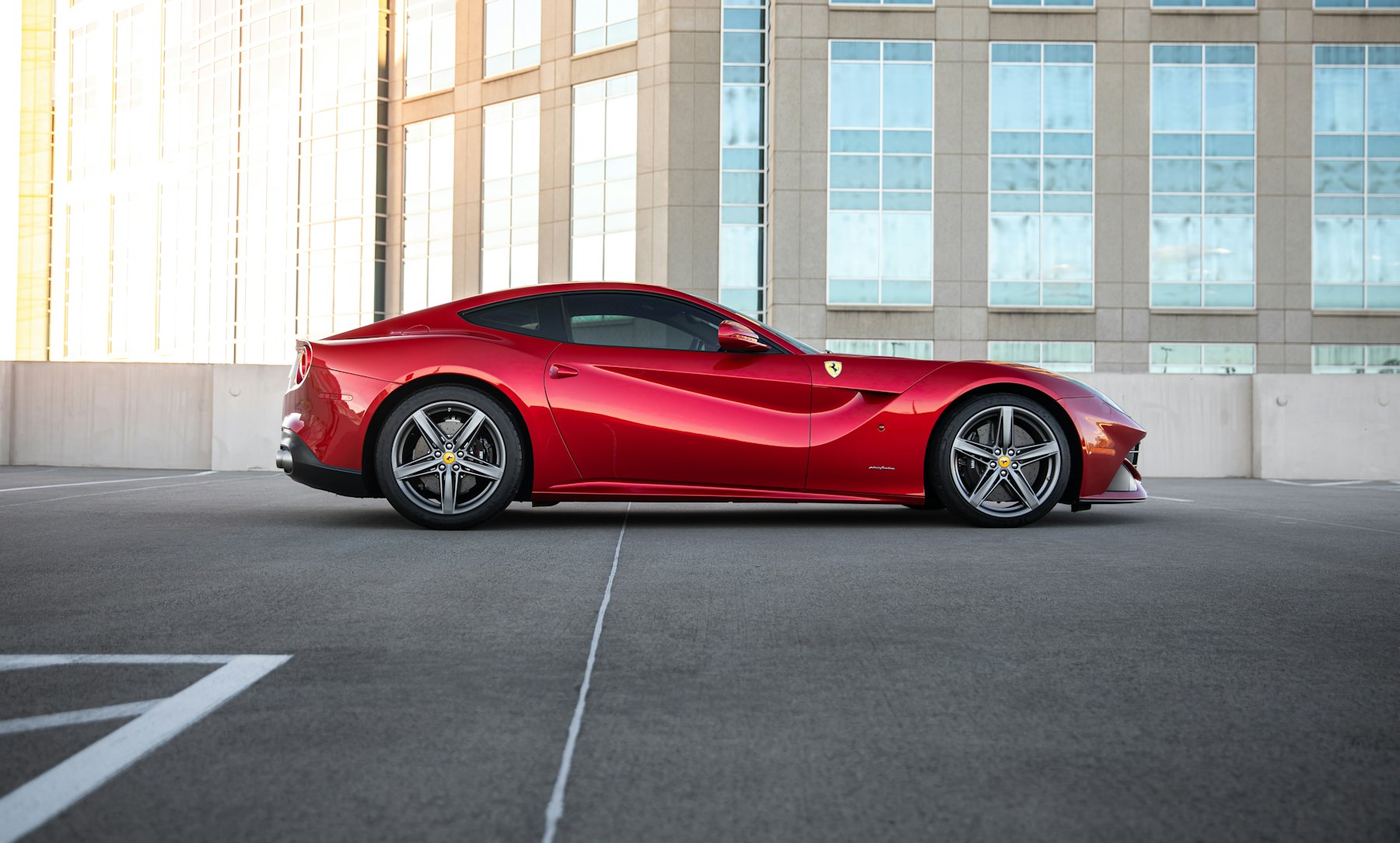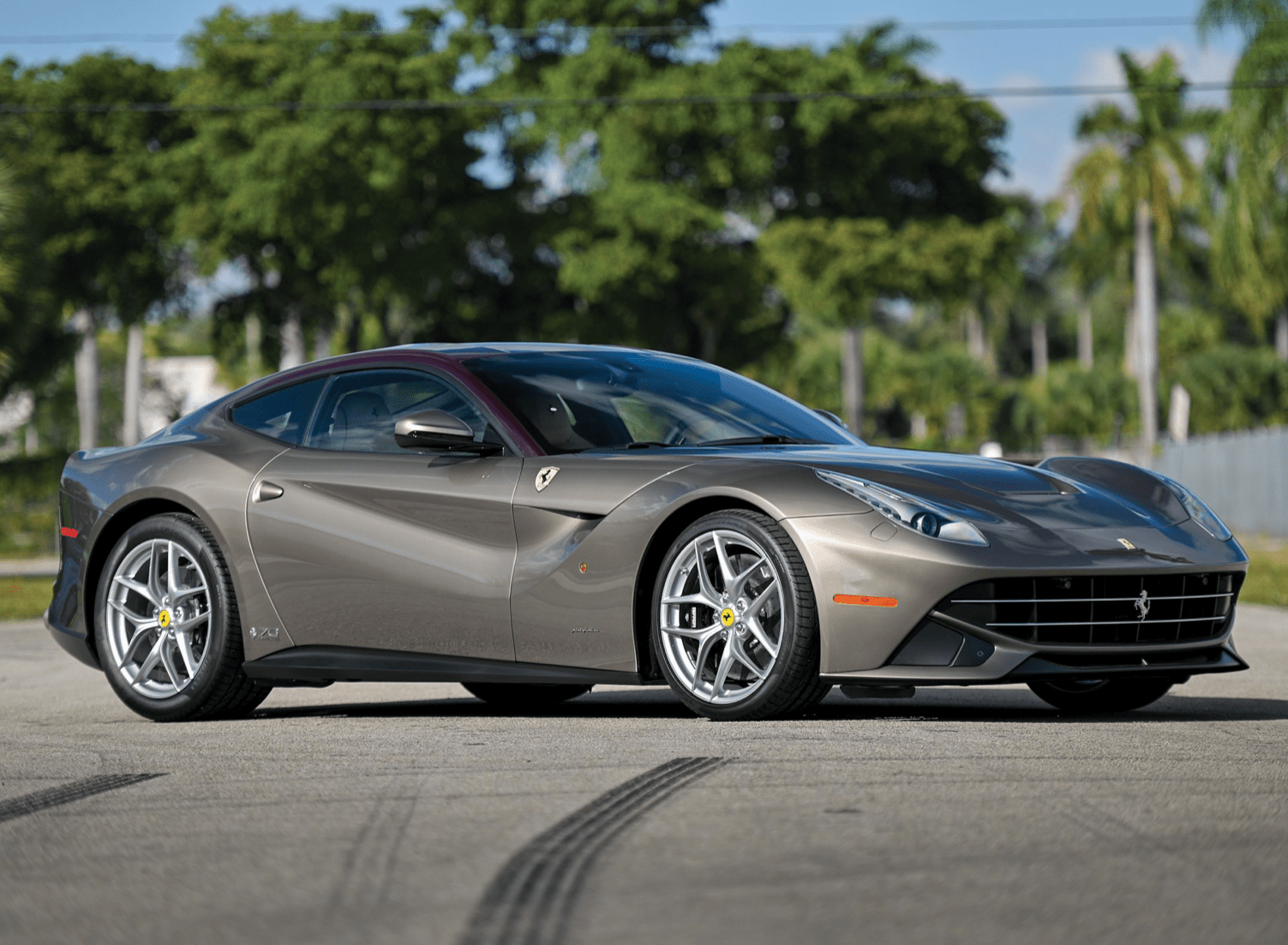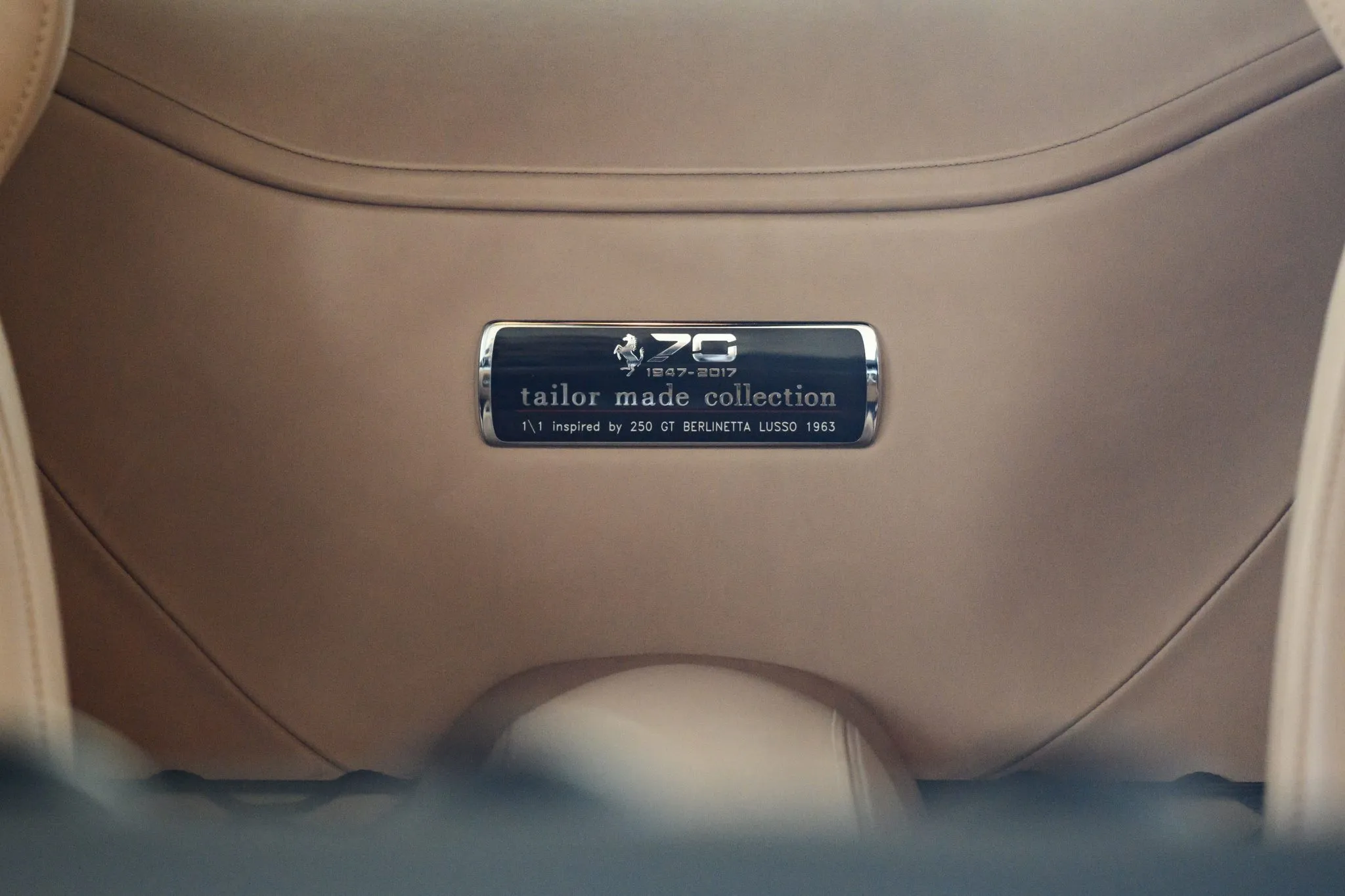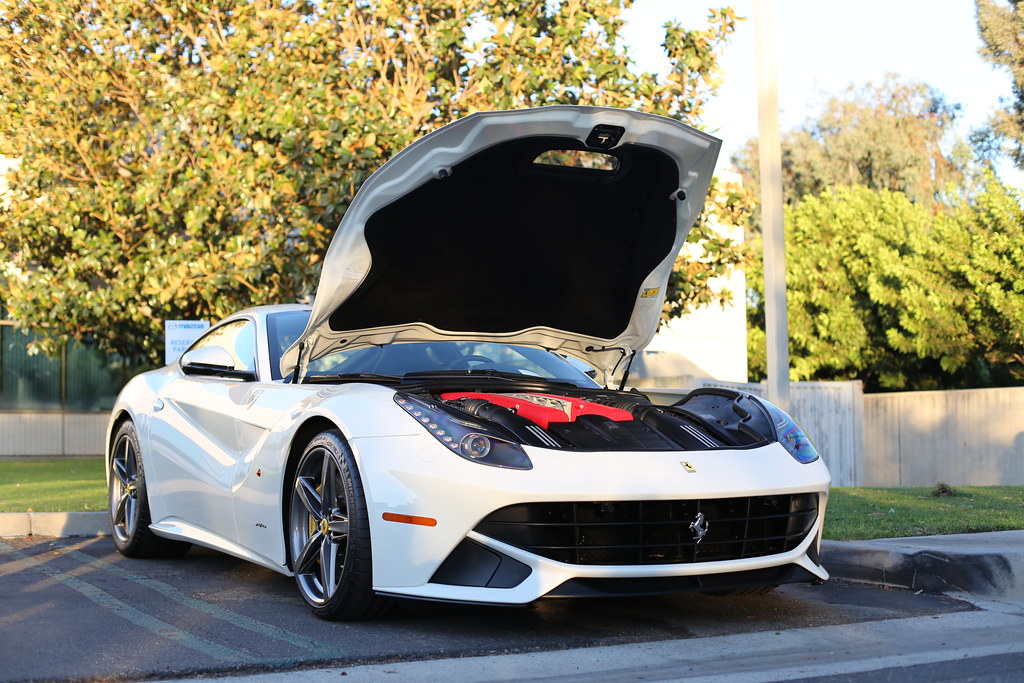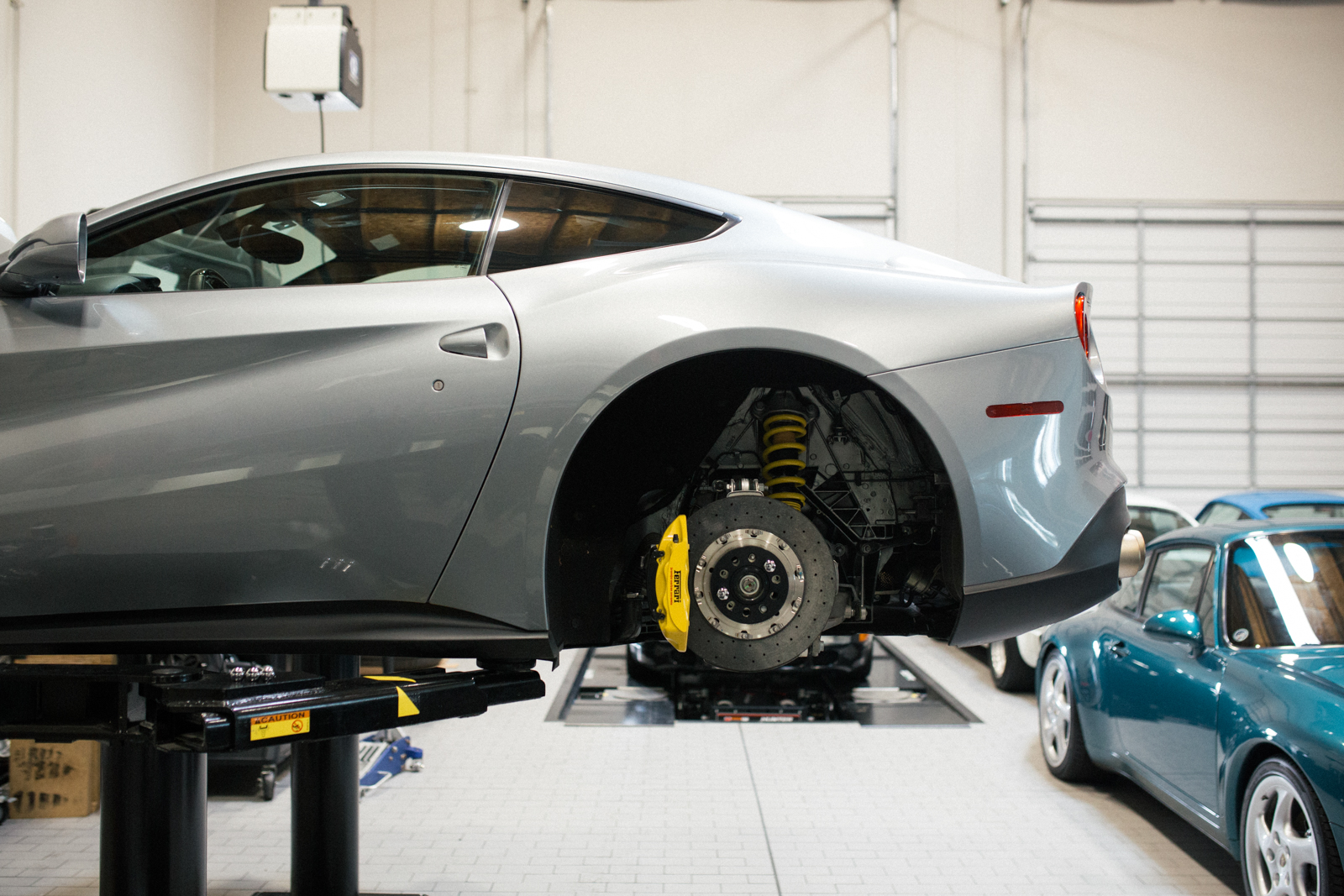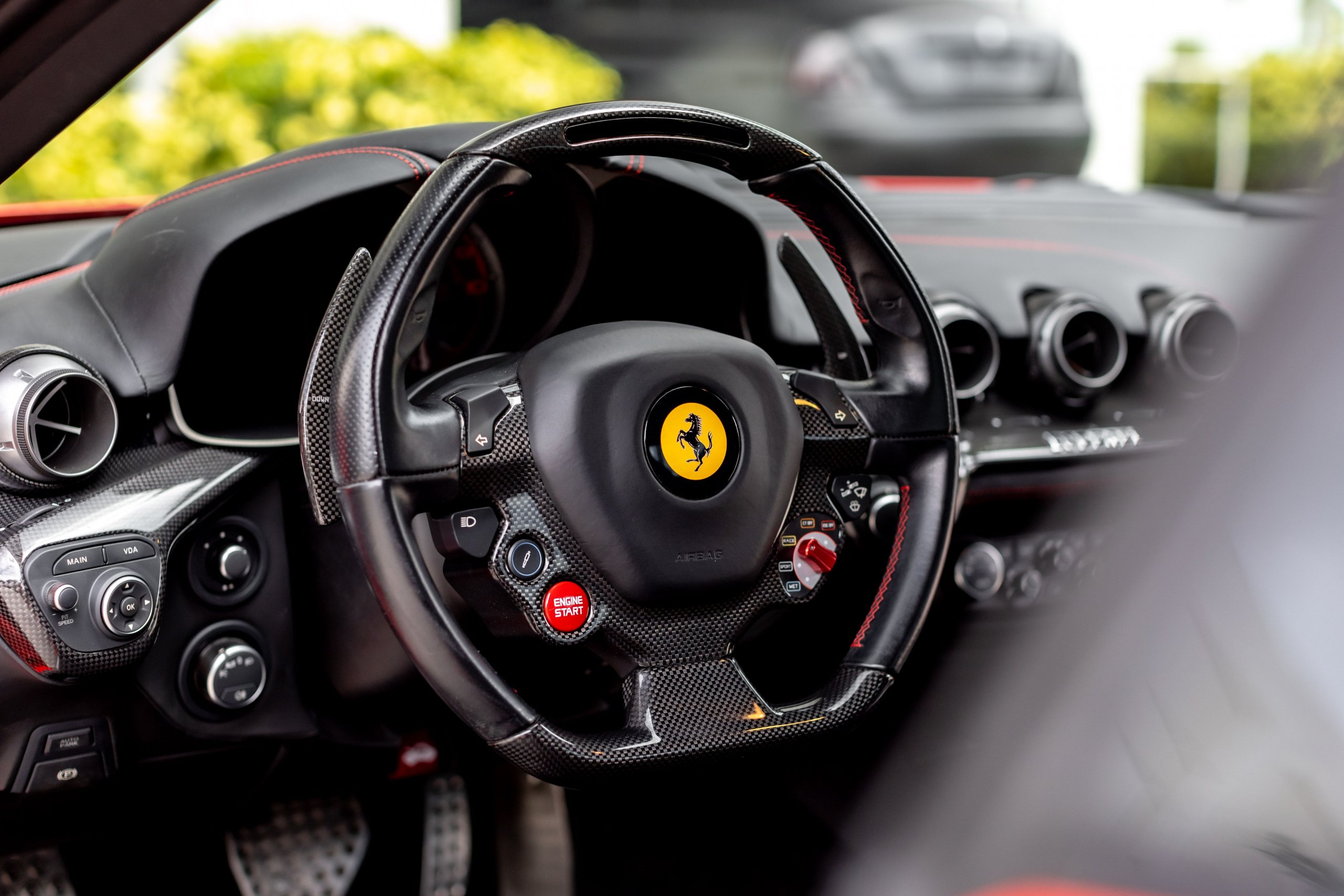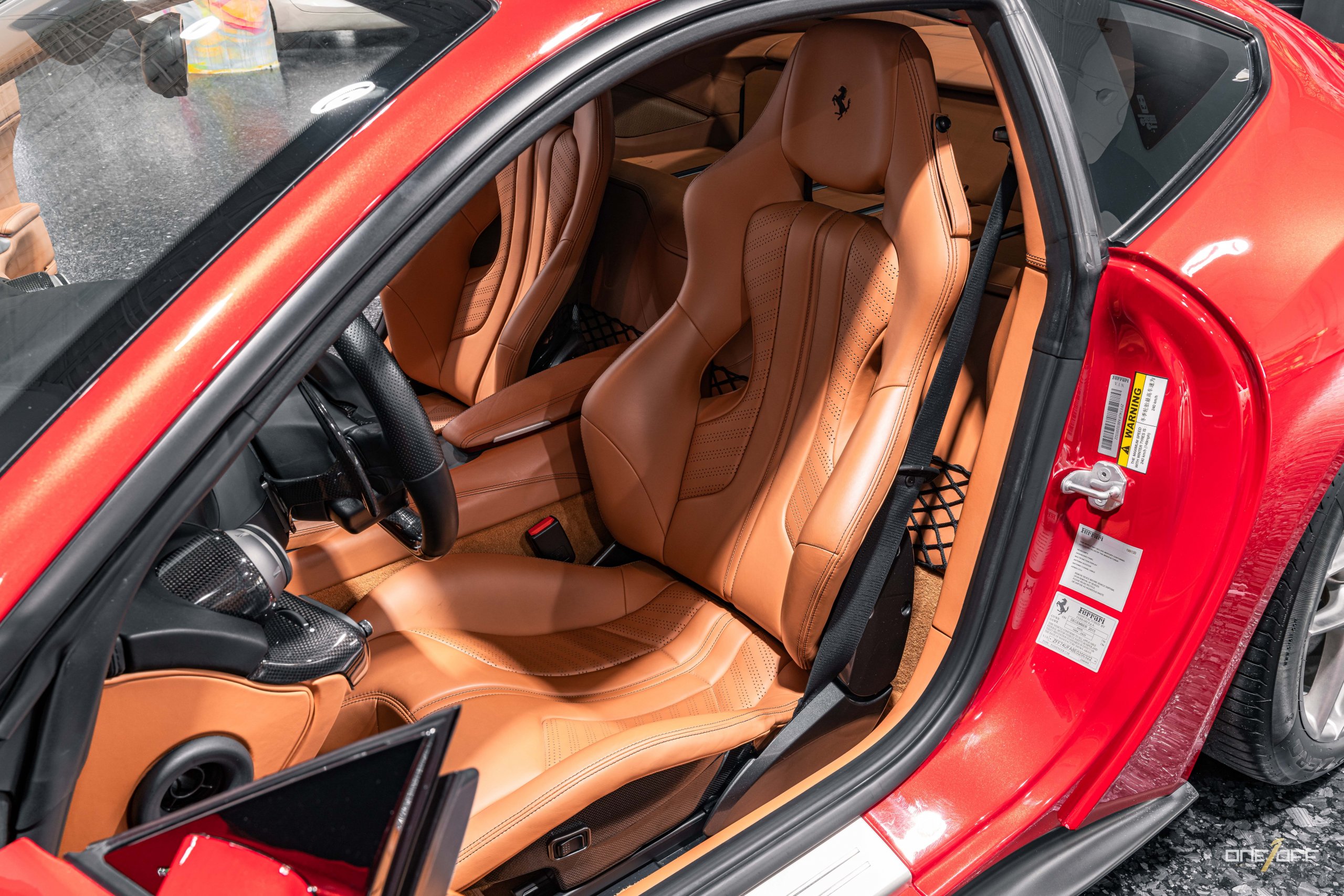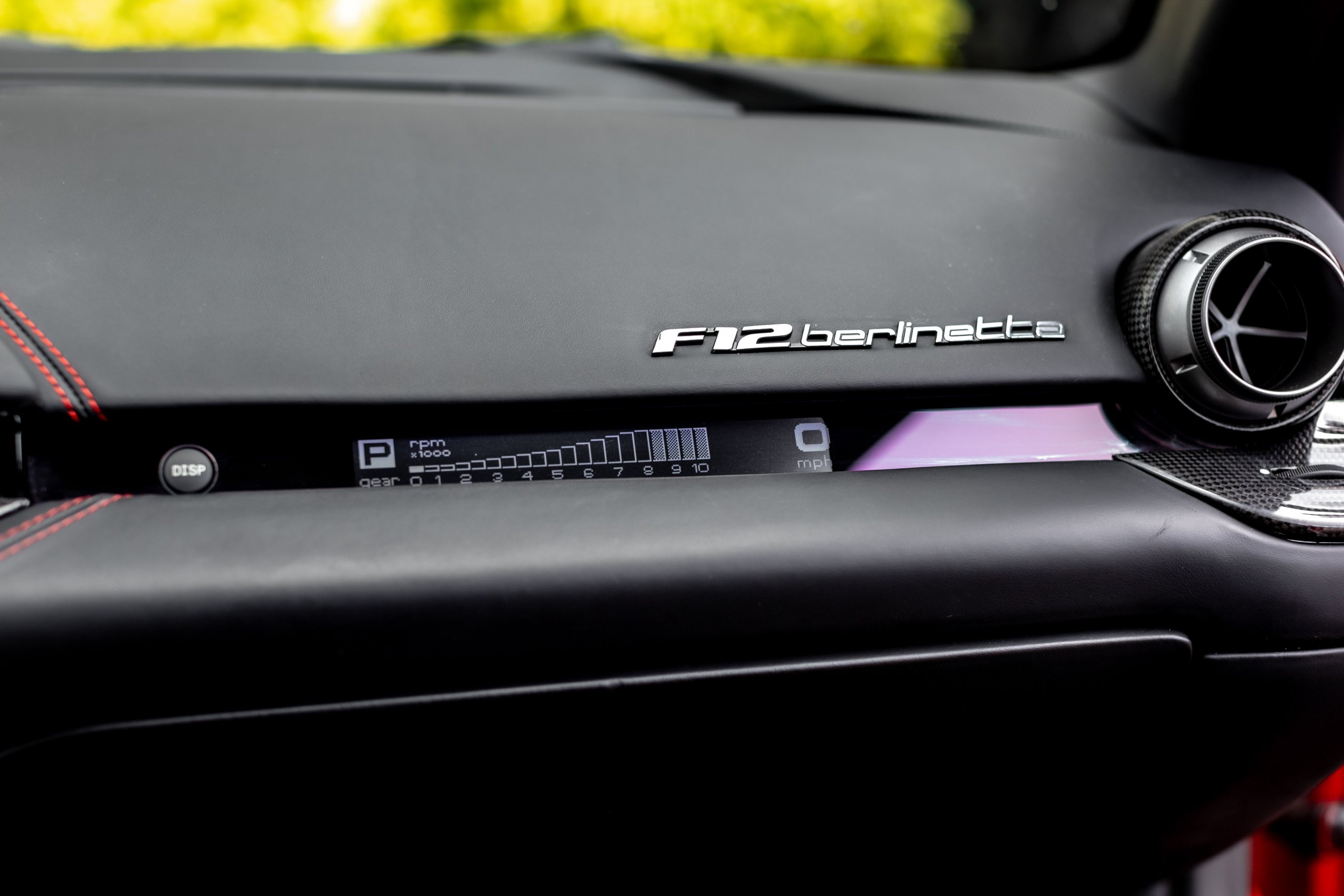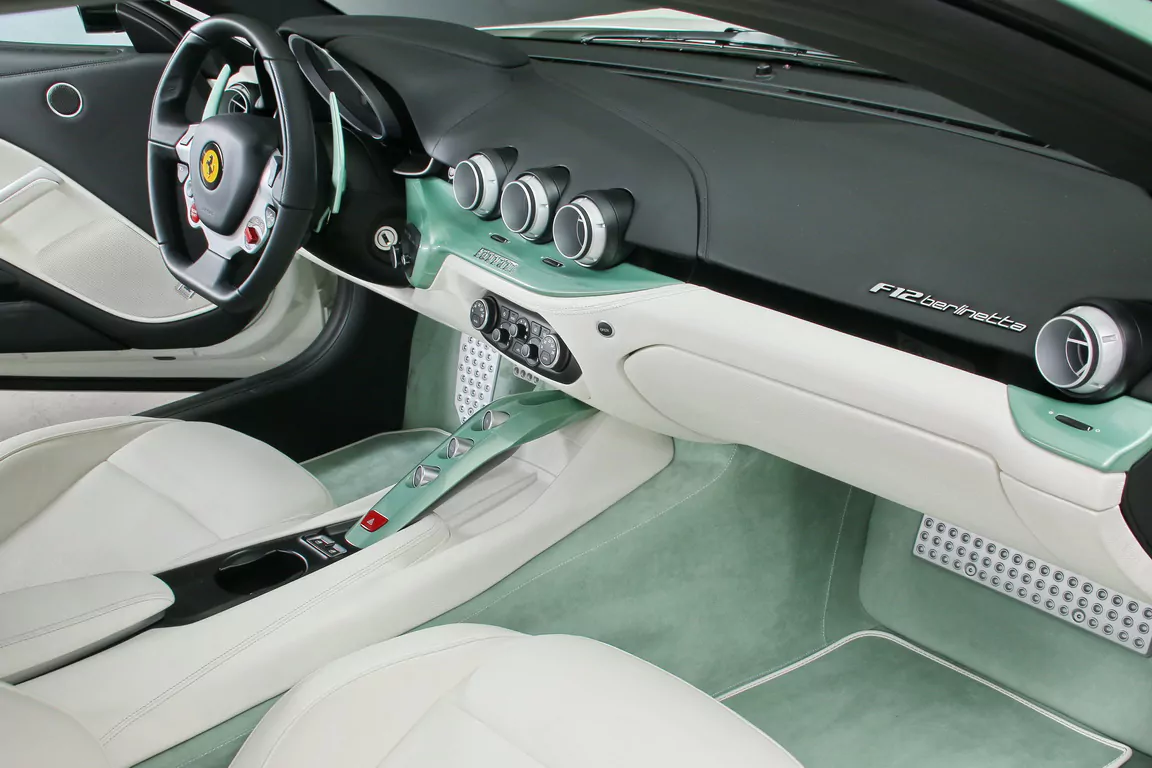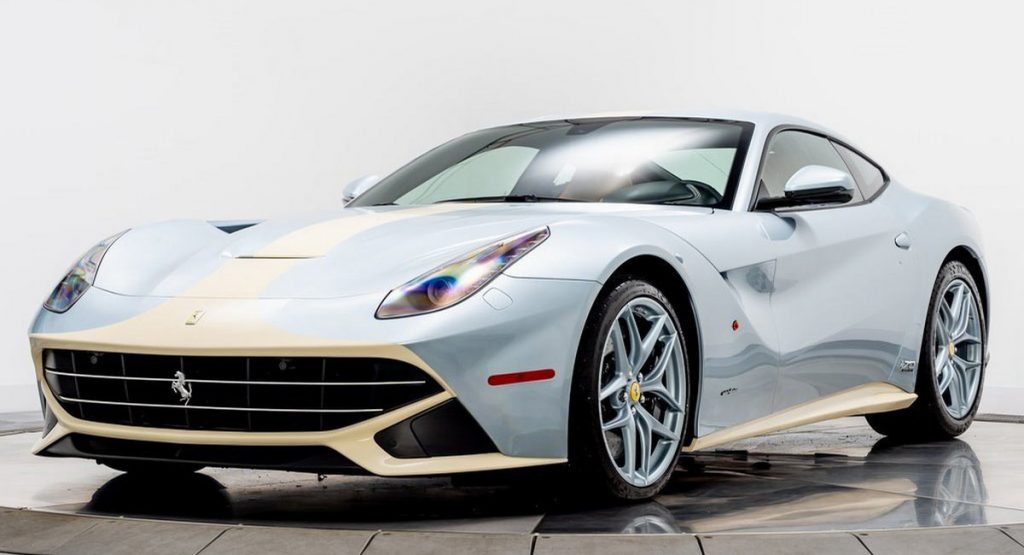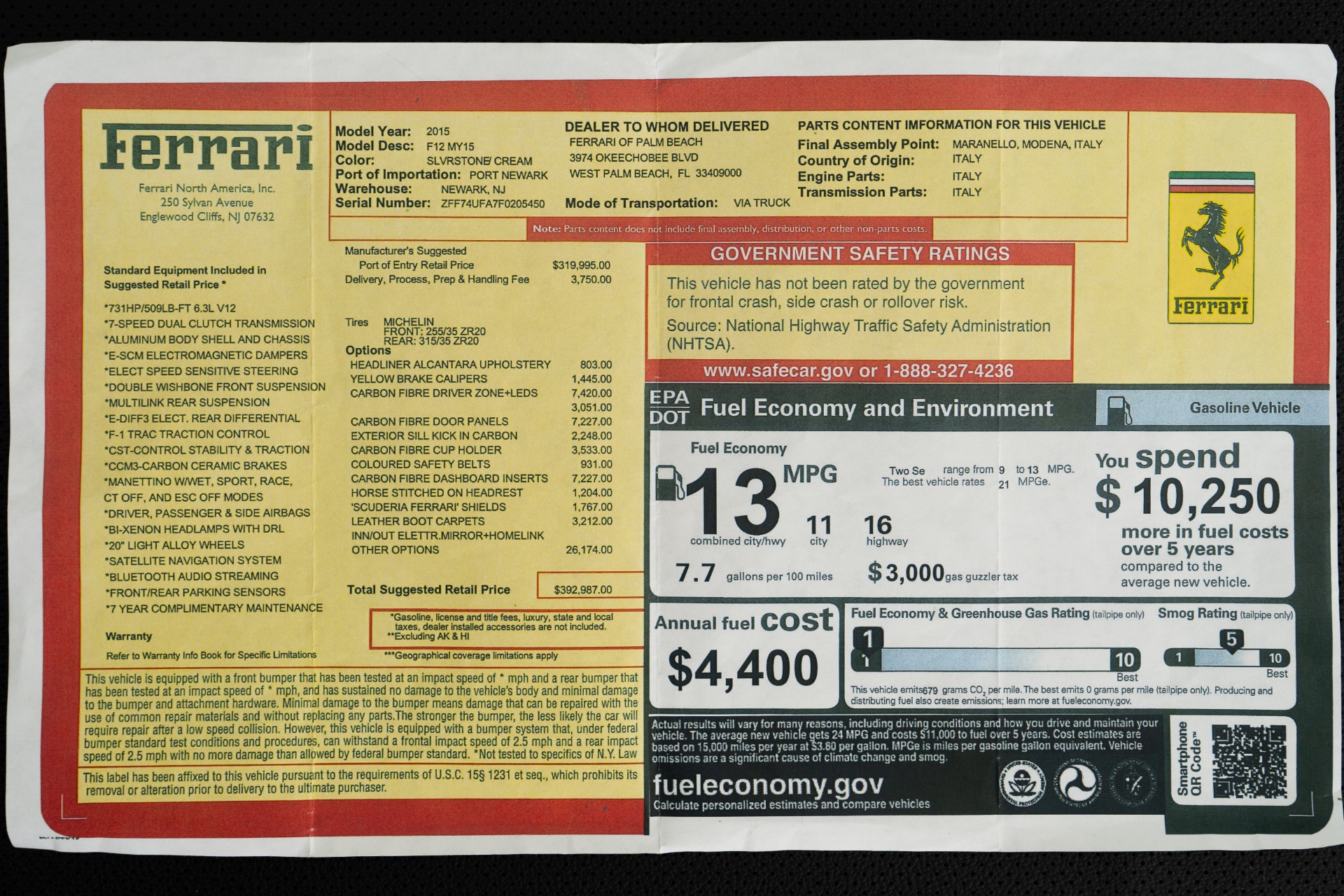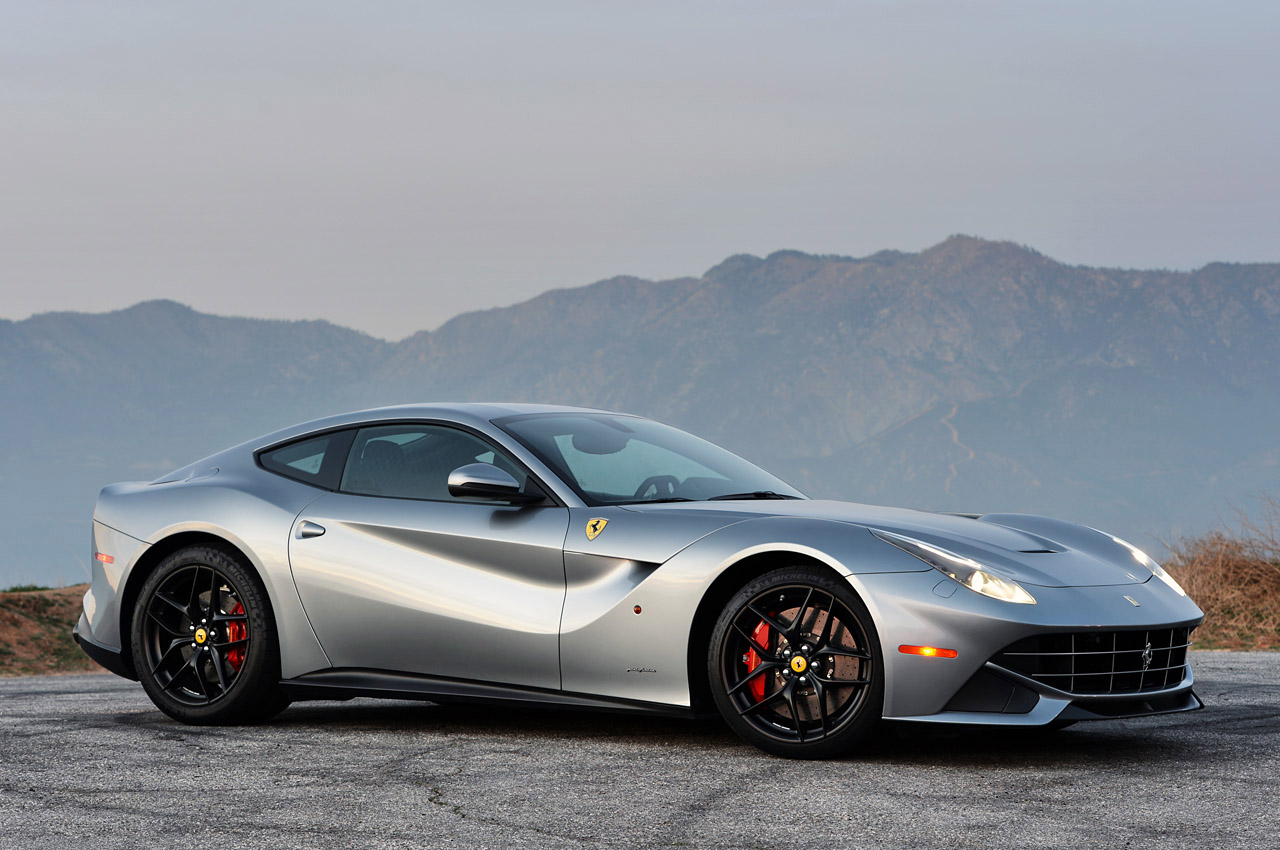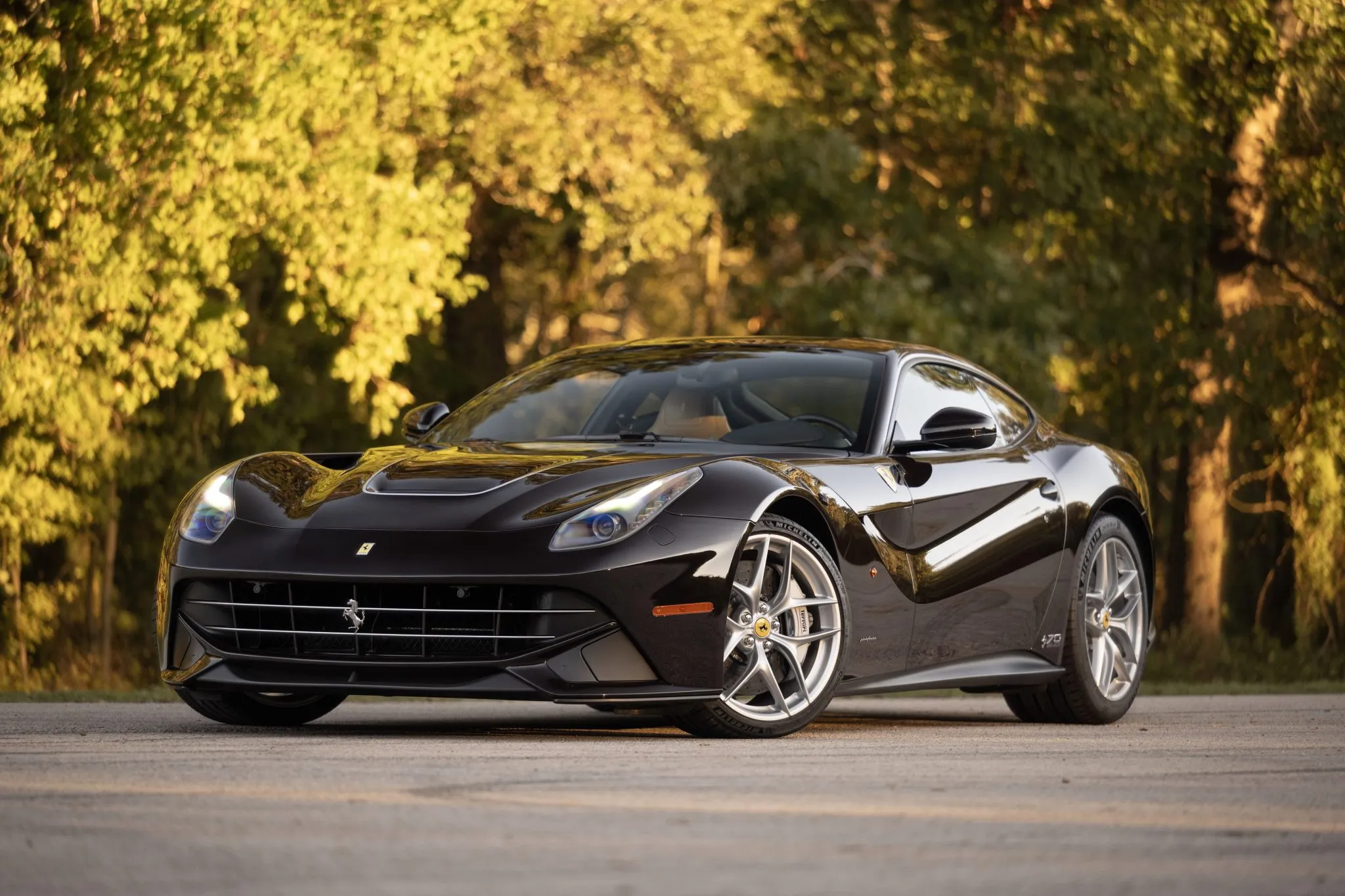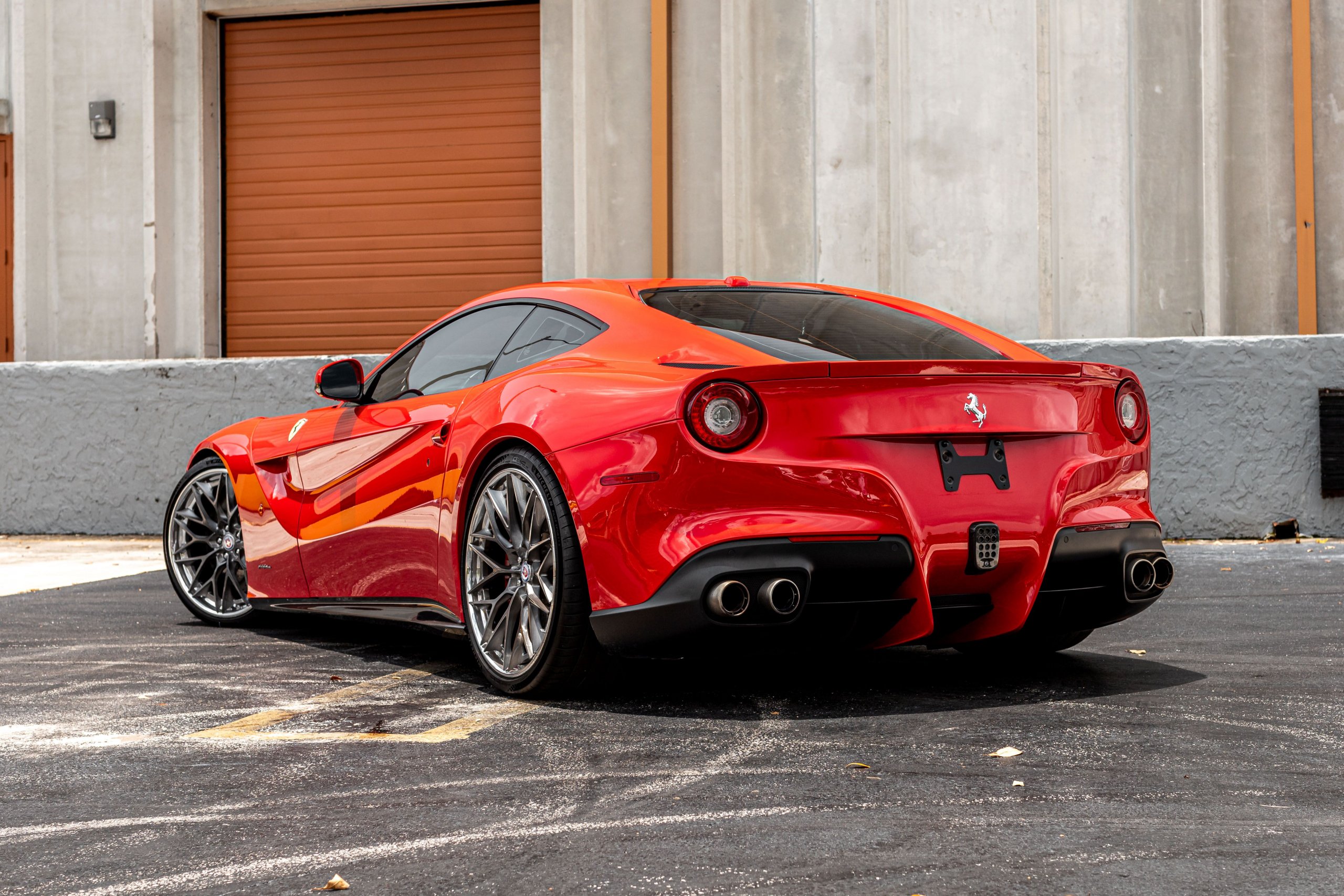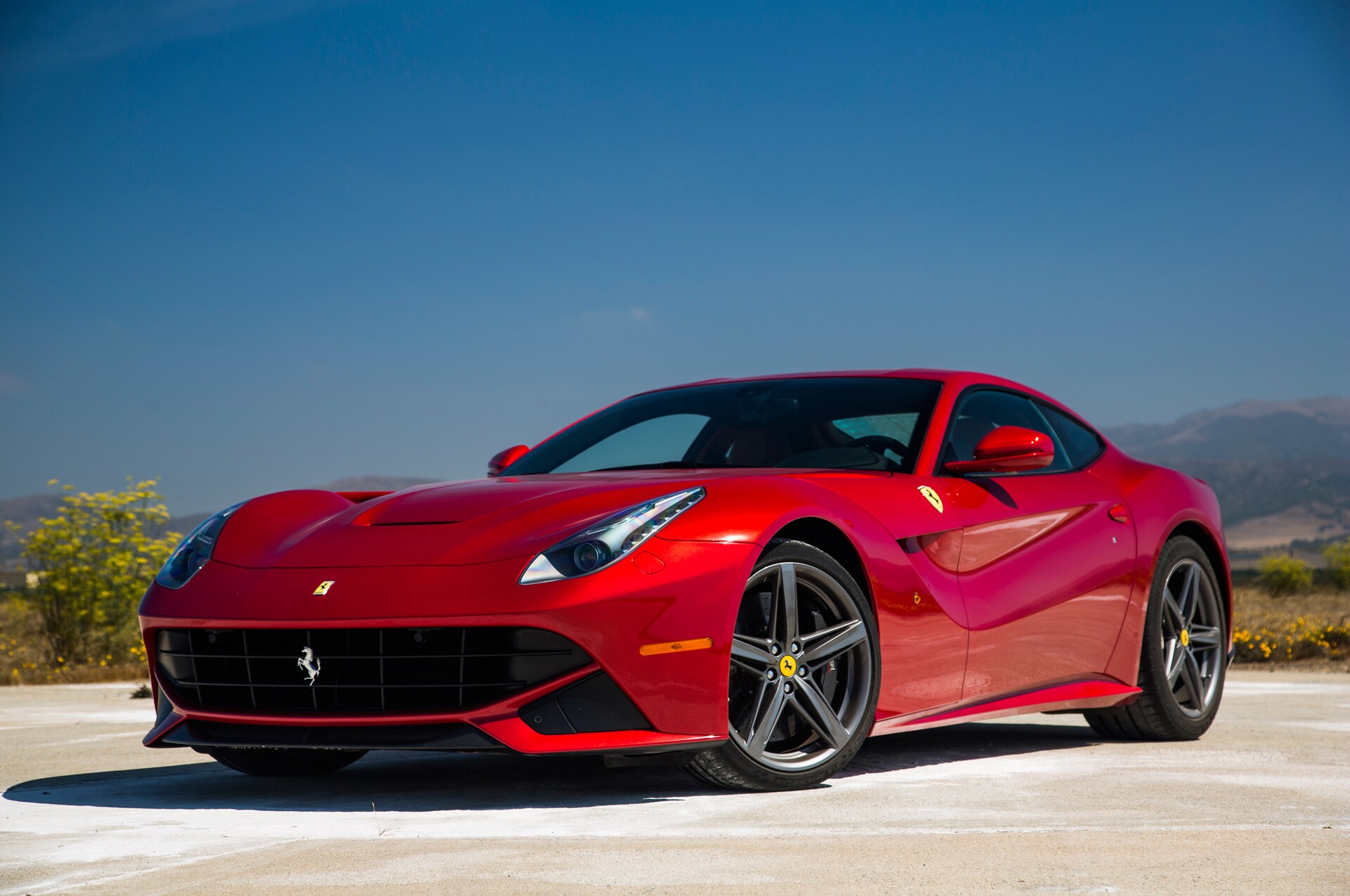When the 2012 Ferrari F12 Berlinetta was introduced, it was a big deal for Ferrari, stepping in after the beloved 599 GTB Fiorano. This wasn't just about bringing in a new car; it was about setting new heights for what a sports car with its engine in the front and power in the back wheels could do.
As the main star of Ferrari's lineup at that time, the F12 mixed the latest tech with classic Ferrari looks. It had big shoes to fill after the 599, aiming not just to match but to wow, combining the best of new technology with that unmistakable Ferrari charm.
Beneath its elegant sculpted hood lies a powerhouse: a naturally aspirated 6.3-liter V12 engine, which was the most powerful road-going engine Ferrari had ever produced up to that point.
Delivering 730 hp, the F12 was capable of accelerating from 0 to 60 mph in just 3.1 seconds, with a top speed of over 210 mph, making it one of the fastest cars grand touring cars at the time.
Beyond its amazing performance, the F12 was praised for its handling dynamics, which were the result of meticulous aerodynamic design and advanced chassis development. This combination ensured that the car not only delivered straight-line speed but also the agility and precision on winding roads and race tracks.
The design of the F12 speaks the language of Ferrari's rich heritage, with sleek aerodynamics, sharp lines, and the brand's signature styling cues, making it unmistakably a Ferrari. The F12's design merges form and function seamlessly, starting with its front bumper that proudly displays the Ferrari stallion emblem, encircled by slats that channel air straight into the engine lurking behind.
The car's doors are subtly indented, a deliberate design choice to improve airflow and enhance aerodynamics. This thoughtful styling is brought full circle with the iconic circular taillights that hallmark its rear, creating the F12's aesthetic and performance ethos.
Inside, the cabin reflects a balance between comfort and performance, incorporating ergonomic design and advanced technology that draws inspiration from Ferrari's relationship with Fiat, enhancing its practicality for daily driving without compromising on the thrill of high-performance driving.
Throughout its production years, the F12 found itself in a competitive rivalry with the Lamborghini Aventador. However, despite its similar price point, the F12 stands out in its category with its naturally aspirated V12 engine and its grand tourer credentials. Additionally, the F12 appeals more to those who seek a more understated presence, preferring to attract less attention than the Aventador typically does.
Model Changes (Breakdown by Year)
2012 Ferrari F12
The 2012 model marked the debut of the Ferrari F12 Berlinetta, replacing the Ferrari 599 GTB Fiorano.
Powered by a 6.3L V12 engine that churns out an impressive 730 hp, it stands out for its remarkable performance.
Its low, sleek profile unmistakably asserts a dominant presence on the road. With a starting base price of approximately $330,000, it positioned itself competitively against the Lamborghini Aventador.
2013 Ferrari F12
For 2013, Ferrari carried forward the groundbreaking legacy of the F12berlinetta from its 2012 introduction, maintaining its brand's prestige without significant updates in performance, design, or technology.
2014 Ferrari F12
In 2014, while the Ferrari F12 remained unchanged from the previous year, Ferrari introduced an element of exclusivity and personalization through its Tailor Made program. This initiative allowed owners to customize their F12 with bespoke touches, offering an array of personalization options that ranged from unique color combinations, interior materials, and trim details.
Though these customizations did not extend to mechanical changes, the program enabled F12 owners to create a vehicle that was uniquely theirs, further enhancing the allure and prestige of owning one of Ferrari's most powerful and elegant models.
This move by Ferrari underscored the brand's commitment to not only delivering unparalleled performance but also catering to the individual tastes and desires of its clientele, ensuring that each Tailor Made F12 was as distinct and unique as its owner.
Despite the absence of new variants or significant updates to the car's performance or design, the introduction of the Tailor Made program in 2014 represented a significant enhancement to the F12's appeal, offering an added layer of exclusivity and personalization to an already outstanding vehicle.
2015 Ferrari F12
In 2015, Ferrari introduced a significant update to the F12 lineup with the unveiling of the F12 TDF (Tour de France), a track-focused variant that took the already great F12 to new heights of performance and driving dynamics.
Limited to just 799 units, the F12 TDF was a tribute to Ferrari’s historical dominance in the Tour de France automobile race, embodying the spirit and performance that Ferrari cars exhibited on those legendary roads.
The F12 TDF boasted a large upgrade in power, with its 6.3-liter V12 engine now producing an astounding 769 hp, up from the 730 hp found in the standard F12. This increase in power, combined with a significant reduction in weight, allowed the F12 TDF to offer an even more exciting driving experience.
The weight savings were achieved through the extensive use of carbon fiber and other lightweight materials, both inside and out, which not only reduced the car's overall mass but also improved its power-to-weight ratio dramatically.
Aerodynamically, the F12 TDF featured substantial enhancements over the regular F12. Ferrari's engineers reworked the car's exterior to include redesigned aerodynamic elements, such as a larger splitter, new aero blades, and louvers on the fenders, which increased downforce without significantly affecting the drag coefficient.
These modifications allowed the F12 TDF to achieve better stability at high speeds and more precise handling, especially on the track.
Driving the F12 TDF was described as an unparalleled experience, thanks to its performance upgrades and aerodynamic improvements. The car's agility and responsiveness were significantly enhanced, allowing for tighter cornering and more aggressive acceleration.
The F12 TDF's dynamic capabilities were further complemented by its revised suspension setup and the introduction of rear-wheel steering, which improved grip and stability during high-speed maneuvers.
In comparison to the regular F12, the F12 TDF was a more extreme, track-focused machine that pushed the boundaries of what was possible in a front-engined, rear-wheel-drive sports car. It retained the essence of the F12's design but added a level of performance and exclusivity that appealed to the most discerning Ferrari enthusiasts and collectors, making it a fitting homage to the brand's racing heritage.
Starting price for the F12 TDF was $490,500.
2016 Ferrari F12
In 2016, the Ferrari F12's journey of refinement and excellence saw its focus shift towards offering clients more personalized customization options and enhancing the car's interior luxury and comfort.
While the core mechanical specifications and the exterior design largely remained unchanged, Ferrari provided its clientele with an expanded palette of customization options, allowing for a more tailored and individual expression of style and luxury.
The minor updates in options included a broader range of exterior colors, new wheel designs, and perhaps more choices in terms of brake caliper colors, allowing owners to make their F12berlinetta distinctively theirs.
Ferrari's Atelier program offers an extensive selection of materials, finishes, and details, enabling buyers to work closely with the manufacturer to create a vehicle that perfectly reflects their preferences and lifestyle.
Interior enhancements for the 2016 F12 focused on elevating the level of luxury and technological convenience within the cabin. This involved the introduction of new leather or Alcantara upholstery options, and more elaborate stitching patterns to keep the F12 at the cutting edge of automotive interior design.
Additionally, 2016 has seen updates to the F12's infotainment system, offering improved navigation, connectivity, and audio system options.
2017 Ferrari F12
In 2017, marking the end of the Ferrari F12's production and Ferrari's 70th year in the business of creating some of the world's most coveted cars, the company rolled out special liveries and editions for the F12. These 70th Anniversary Editions were a tribute to Ferrari's rich heritage and its unbroken lineage of automotive excellence and only 70 of these F12’s exist.
The 70th Anniversary Editions introduced for the F12 featured unique customization options that went beyond the standard offerings. These included a range of specially designed liveries that paid homage to iconic Ferraris from the past, allowing owners to own a piece of Ferrari history.
Each livery was inspired by a story or a specific model that had left an indelible mark on the brand's legacy, offering a blend of Ferrari's racing heritage and its prowess in creating road cars that are as beautiful as they are powerful.
In terms of interior enhancements, these special editions included exclusive upholstery options, bespoke trim elements, and commemorative badging, emphasizing the uniqueness of the vehicle and the significance of Ferrari's 70th anniversary.
Ferrari F12 Common Problems
Despite what one might assume about its mechanical intricacies, the Ferrari F12 stands as one of the most dependable V12 grand tourers ever produced.
Many people have driven their Ferrari F12s for extended distances, many with higher miles, proving its reliability.
However, it is essential to keep in mind that all cars, even supercars, can have issues and it is crucial to perform a Pre-Purchase Inspection (PPI) from an authorized dealer or experienced independent mechanic to reveal all issues.
Wonky Starter Motors: Some Ferrari F12 models have experienced issues with their starter motors, which can result in unreliable starting performance. This problem may manifest as difficulty in starting the engine or inconsistent start times, potentially due to electrical or mechanical faults within the starter system.
Rough-Shifting Transmissions: The F12's 7DCL750 transmission, known for its quick and smooth gear changes under optimal conditions, has been reported in some cases to shift roughly. This issue can be particularly noticeable at low speeds or during downshifts. Additionally, there have been instances where this transmission may leak fluid, a condition that could lead to operational inefficiency and require professional repair to prevent further mechanical damage.
Peeling Paint: Aesthetic concerns have arisen with the F12 regarding its paintwork, with reports of paint peeling in certain areas. This issue detracts from the vehicle's otherwise impeccable appearance and may be due to factors such as improper application during manufacturing, environmental stresses, or the quality of the paint used.
Leather Shrinkage on Dashboard and Rear Sunscreen: The Ferrari F12's luxurious interior is not without its flaws. Owners have noted that the leather on the dashboard and the rear sunscreen can shrink over time. This shrinkage not only affects the visual appeal of the interior but can also lead to cracking and damage to these leather components, likely caused by exposure to sunlight and temperature variations.
Creaking from Torque Bolts in Rear Driveshaft: There have been reports of creaking noises emanating from the rear driveshaft area, specifically linked to the torque bolts. This noise can indicate that the bolts are not maintaining their proper tension, potentially affecting the driveshaft's alignment and operational smoothness, and might require retightening or replacement of components to resolve.
Corrosion at Rear Mesh: Corrosion issues have been identified at the rear mesh of some F12 models. This problem can compromise not just the vehicle's aesthetics but also the integrity of the mesh itself, which is crucial for protecting underlying components from debris while ensuring adequate ventilation. Corrosion in this area can be attributed to moisture accumulation and environmental exposure, necessitating regular inspection and maintenance to prevent deterioration.
Each of these issues highlights the importance of regular, comprehensive maintenance and prompt attention to any signs of wear or failure to ensure the Ferrari F12 remains in peak condition.
Recalls
2013-2017 F12 Berlinetta, 2017 F12 TDF vehicles
Service brakes, hydraulic (Recall no. 22V536000)
The brake fluid reservoir cap may not vent properly, creating a vacuum inside the brake fluid reservoir, and resulting in a brake fluid leak that may lead to a partial or total loss of brake function.
2015-2017 F12 Berlinetta, 2016 F12 TDF vehicles
Air bags (Recall no. 19V411000)
The air bag Electronic Control Unit (ECU) may malfunction, possibly causing the non-deployment or improper deployment of the air bags and/or seat belt pretensioners.
2017 Ferrari F12, 2016-2017 Ferrari F12 TDF vehicles
Air bags: Frontal: Passenger side: Inflator module (Recall no. 19V006000)
These vehicles are equipped with certain air bag inflators assembled as part of the passenger frontal air bag modules used as original equipment or replacement equipment. In the event of a crash necessitating deployment of the passenger frontal air bag, these inflators may explode due to propellant degradation occurring after long-term exposure to absolute humidity and temperature cycling.
2013 Ferrari F12 vehicles
Air bags (Recall no. 18V040000)
These vehicles are equipped with certain air bag inflators assembled as part of the passenger frontal air bag modules used as original equipment or replacement equipment. In the event of a crash necessitating deployment of the passenger frontal air bag, these inflators may explode due to propellant degradation occurring after long-term exposure to absolute humidity and temperature cycling.
Ferrari F12 Berlinetta vehicles manufactured December 19, 2014, to April 29, 2015
Air bags: Frontal (Recall no. 15V433000)
The affected vehicles may be equipped with a driver side air bag module that was improperly assembled. This can cause the air bag to deploy in a rotated orientation.
Maintenance and Ownership Costs
While historically, maintaining a Ferrari V12 has been quite costly, the F12 is regarded as having comparatively modest maintenance needs.
However, it is important to remember that regular maintenance and repairs will still be necessary, and the costs can vary depending on whether you take your car to a dealer or an independent mechanic.
Here is the suggested service schedule and intervals per Ferrari:
ANNUAL OR EVERY 6,000 MILES (Minor Service):
- Replace Engine Oil & Filter
- Replace Brake Fluid
- Brake Inspection
- Indicator Light check
- Inspection of Transmission & Differential Assembly
- Top-Up Power Steering Fluid if Necessary
- Inspect Transmission Oil & Top-Up if Necessary
- Inspect Front & Rear Suspension Systems
- Inspection of Tire Wear
EVERY 3 YEARS OR 25,000 MILES (Includes 6,000 Mi Service Plus):
- Replace Transmission Fluid
- Replace Spark Plugs
- Replace Air Filter
- Replace Coolant
- Tightening of Engine & Transmission Mounts & Fasteners
- Replace Auxiliary Belts
EVERY 6 YEARS OR 50,000 MILES (Includes 25,000 Mi Service Plus):
- Replace Water Pump
- Replace Auxiliary Belts
- Check for wheel bearing play, Replace if necessary
Here is a rough estimate of typical service costs associated with the Ferrari F12:
- Oil Change - The Ferrari F12berlinetta requires a higher grade of oil and a more extensive labor process, costing approximately $800 for an independent specialist and upwards of $1,200 at a Ferrari dealership.
- Minor Service - This service generally includes an oil change, replacement of the cabin air filter, and engine air filter. For the F12, due to its high-performance specifications and the quality of parts required, you can expect to pay around $3,000 at a Ferrari dealership.
- Major Service - In addition to the items covered in a minor service, major service for an F12 typically includes the replacement of spark plugs, a brake system flush, and a transmission fluid flush. Given the Ferrari's specialized needs and parts, this service can cost around $5,000 when performed at a Ferrari dealership.
- Tires - A set of premium, high-performance tires suitable for the F12, such as the Michelin Pilot Super Sport, could cost in the region of $2,500 to $3,000 due to the car's specific size and performance requirements.
- Brakes - The Ferrari F12 uses carbon-ceramic brake rotors, designed to last the vehicle's lifetime under normal driving conditions. However, the cost for a set of aftermarket OE-equivalent brake pads can run about $1,000 to $1,500.
- Clutch - The F12 features a dual-clutch transmission engineered for high performance and longevity. It is designed to last the life of the car under normal use, so typically there would be no additional expenses for clutch or flywheel service.
Please note that these costs can vary based on location, the specific model year of the F12, and the extent of use it has seen. It is always recommended to have these services performed by qualified Ferrari technicians to maintain the car's performance and value.
Options List
When it comes to purchasing a Ferrari used, it all comes down to three key points: Options, options, and options.
When considering the resale value of the Ferrari F12, certain features are highly sought after by potential buyers. Among these, the carbon fiber steering wheel, carbon bucket seats, and Scuderia shields are almost universally coveted. These items tend to stand at the top of the list for enthusiasts looking to acquire a pre-owned F12.
Further enhancing the appeal, options such as the carbon fiber interior and exterior trim, the aforementioned carbon fibre steering wheel, the Homelink mirror, a front lift system, and a parking camera are often the first checked boxes on a buyer's wish list. These features not only contribute to the aesthetic and functional value of the vehicle but also signify a well-optioned F12.
In addition to these primary options, there are secondary features that, while not as critical, are still desirable for adding an extra touch of luxury or personalization. These include the iconic prancing Horse stitched on the headrests, black inserts for the outer mirrors, and a selection of optional wheel designs.
Thee details may not be deal-breakers but they do make the vehicle stand out and can tip the scales for buyers looking for a particularly well-appointed example of the F12.
Finally, a handful of F12 customers also went through the Atelier and Tailor Made program by Ferrari. The Atelier program offers an extensive range of additional customization options for the Ferrari F12 that go beyond what you might find in the standard dealer configurator.
These options allow for a higher degree of personalization and access to unique features that are not typically offered through the standard purchasing process.
On the other hand, the Tailor Made program takes customization to the highest level, providing an expansive array of personalization choices that stretch the boundaries of what's possible. This program is akin to having a blank canvas where almost any vision of personal taste can be brought to life.
It offers an extensive selection of paints, fabrics, leathers, and other materials, enabling customers to create a truly bespoke Ferrari that reflects their individual style and preferences to the finest detail.
Because of the strict approval requirements, cars that went through the Atelier and Tailor Made program are considered highly desirable.
These cars usually command a higher premium in the market due to their exclusivity and uniqueness.
Here are some examples of option changes
Some of the more desirable options to look for include:
Carbon fibre package (interior, exterior)
Carbon fibre steering wheel
Carbon bucket seats
Scuderia shields
Front lift
Parking camera
Atelier or Tailor made options
2015 Ferrari F12 options list
Ferrari F12 Price and Values (F12 TDF)
The Best Ferrari F12 to Buy
When it comes to buying a F12, there are a few key factors to consider that can affect the car's long-term value.
For F12s that will most likely continue to climb in value will be the special edition F12 TDF. Although they are already very expensive, they are extremely desirable and regularly traded for high dollar value with no sign of depreciation.
F12 70th Anniversary Editions are also quite rare and desirable, as every single one of the 70 cars built is all spec’d differently in unique heritage colors and interior options, they are a safe choice to purchase.
Despite the Ferrari F12 undergoing only a few minor updates and changes throughout its production years, each model released is considered a solid purchase. The F12 has consistently maintained a high standard of quality and performance, ensuring that every iteration, from its initial release to the final models, represents a robust and reliable choice for enthusiasts and collectors alike.
Whether early or later models, the F12 stands as a testament to Ferrari's commitment to engineering excellence, making any of them a worthy addition to a connoisseur's garage.
In the current market, as cars increasingly adopt hybrid technology, collectors and enthusiasts are developing a heightened appreciation for naturally aspirated V12s, making them highly desirable.
In addition, the condition and mileage of the car are also important factors to consider when buying an F12. The ones that are more likely to retain their value in the long run and will fetch the most money will be a well-maintained car with low mileage.
Therefore, it's important to do your research, compare prices, and look for well-maintained cars if you are considering purchasing an F12 with the goal of not losing any money.
Conclusion
In summary, with a price tag starting at around $240,000, the Ferrari F12 emerges as an excellent contender for those seeking their grand touring supercar experience. It's not only reliable but also impresses with its performance and the symphony of its engine. The F12 distinguishes itself as the supercar of choice for the discerning gentleman.
While the Lamborghini Aventador may be a viable alternative, the F12's blend of exhilarating performance and refined elegance places it in a league of its own.
Ultimately, if you're in the market for a supercar that offers both grand touring luxury and thrilling performance, the F12 should be at the top of your list, promising a decision that's as rewarding as it sounds.
Car Hacking Shortcuts
Make sure the car has a front lift system
2013 to 2017 model years are great hacks
Spec matters: Look for any F12 with Atelier or Tailor made options
F12 TDF is a highly desirable collector car
F12 70th Anniversary Edition are underrated
Carbon fibre package is desirable
Look for well-maintained, low miles F12

